For the past several years I’ve been asked to come up with holiday viewing suggestions at this time of year. (Well, mostly I’ve been asked. I may have occasionally offered unsolicited advice.) I’ve offered cases various and sundry for why you should put down that copy of Frank Capra’s It’s a Wonderful Life (1946) and why you should pick up Bob Hope in The Lemon Drop Kid (1951). I’ve suggested other alternatives to the standard fare, ranging from the overt sentimentality of Mitchell Leisen’s Remember the Night (1940) to the considerable cynicism of Ted Demme’s The Ref (1994). (Psst—Remember the Night is on TCM at 11:15 p.m. on Christmas Eve and again at 6:15 a.m. Christmas Day.)
Well, this year you’re on your own. Instead, I’ll tell you what I’m planning on watching and let it go at that. After several weeks of being subjected to the “best” (read: best bet for an award) the movies have to offer for 2008, I’m more than ready for a bracing dip into the realm of the less weighty, so I’ve decided that, for me, it’s Christmas with Jolie. By that I mean Al Jolson—one time “world’s greatest entertainer” and the guy who is most associated with the birth of the talkies.
Born Asa Yoelsen in Tsarist Russia (actually, Lithuania) in 1886, the boy Jolson followed his father, Cantor Moses Yoelsen, to Washington, D.C., where he seems to have almost immediately found himself in the realm of entertaining. I say “seems” because it’s always been hard to separate the truth from the myth where Jolson’s concerned. Let’s be honest, the world’s greatest entertainer was also the world’s biggest egomaniac, who never let the truth get in the way of a good story, especially if it added to his own reputation. We are here talking about a man who occasionally insisted his name be listed as one of the composers of songs he was to sing—not because he actually had anything to so with writing them, but because his performing them was what would make them hits. He wasn’t entirely wrong, but it’s certainly a tad on the arrogant side.
These days Jolson presents something of a problem to modern sensibilities, owing to his appearances in blackface. It’s more than a little ironic that the man who did much to bridge the gap between black and white culture, helped promote a number of black performers and constantly fought for civil rights should be in this position. It should also be noted that blackface was a theatrical convention of the time (even black performers used it) and neither Jolson, nor anyone else considered it offensive or demeaning. However, this doesn’t change the fact that a lot of people are uncomfortable with it these days, and the fact that Jolson brought the tradition over into his film work is often seen as a downside.
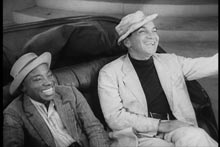
Only two of his starring films don’t feature blackface numbers—the frankly dreadful Say It with Songs (1929) and, his arguably best movie, Hallelujah, I’m a Bum! (1933)—while one, Big Boy (1930), actually presents him as a black character for the entire film. The truth is that even in Big Boy—where Jolson is merely committing his popular stage character, Gus, to film—Jolson is never really anybody but Jolson and no attempt is made to disguise this. The whole thing is actually on the surreal side. What you have is a Lithuanian Jew generally playing a gentile (or at least bearing a very Anglicized name) pretending to be a black man, while cracking jokes about his Jewishness. Spend a few minutes pondering how truly bizarre that is.
The upshot of all this, however, is that Jolson’s film work has tended to fall into obscurity. To date, the only Jolson starring vehicles to make it to DVD are The Jazz Singer (1927) and Hallelujah, I’m a Bum. The first is of too much historical importance to ignore and the second has no blackface. A few of the films did make it to VHS and Jolie’s entire Warner Bros. output made it into a box set of laserdiscs, which I was fortunate enough to acquire when it was available. The rest languish in vaults with occasional airings on TCM.
However, let’s be honest about this—it’s not just the blackface. The movies themselves are often not very good, especially the early talkies and the presence of a ready market for them is debatable at best. It can also be added that it’s always been said that the movies weren’t a good fit for Jolson. That may be true. Only a part of his electric personality registered on film where he couldn’t feed off the energy of a live audience. In an attempt to make up for this, Jolson himself tended to overcompensate with a lot of eye-rolling and a thick slice of something that wouldn’t be served in his own household.
Admitting this as a downside, we have to remember that these—along with his recordings—are all we have to go on today. Jolson died in 1950 before a lot of us (yes, even me) were even born. To even get a taste of what Jolson was like, his movies are our only recourse. And they do provide a taste and even more. They afford the patient viewer—and some of these do require patience—insights into what made him the world’s greatest entertainer if only because it’s so abundantly obvious that only his larger-than-life presence could have made those early talkies even remotely popular. (And they were that—his second feature, The Singing Fool [1928], was the box office champion for years, until a little item called Gone With the Wind knocked it off its pedestal in 1939.) The films may be largely trashy melodramas, but the force of Jolson’s personality puts them across. Even in often battered prints with substandard sound one thing shines through—that perhaps no one was ever more incredibly alive than Al Jolson.
There’s more, too, because there are glimmerings of his unbridled ego, his manic drive for success, his need for audience adulation, and even his purported bisexuality. This last is something Jolson’s early biographers tended to either ignore, not notice, or sweep under the carpet, which is a little odd when you look at the films now. Maybe it’s simply a case of seeing it because the subject has been broached, but it’s hard to imagine that outrageous camp elements in Jolson’s performances could have been missed. If nothing else, the “boys will be boys” gag in Wonder Bar (1934)—where Jolie watches while a man cuts in on a dancing couple, only to dance off with the man, prompting that comment—suggests a strong sympathy and acceptance for sexual ambiguity.
Now, I’m not suggesting anyone else necessarily should consider spending Christmas with Jolson, but that’s what I’m planning, and here’s how I intend to go about it. I’ll start with The Jazz Singer, but if it’s all the same to everybody (and even if it’s not), I’m going to this strictly for the highlights. Yes, it’s a fascinating film with its story of Jewish assimilation in the face of traditional resistance from a parent—complete with Jakie Rabinowitz (Jolson) transforming himself into Jack Robin. In fact, it was so fascinating that by the time the movies got around to giving Jolie the biopic treatment in 1946 with The Jolson Story, the scenarists—probably with Jolson’s help—seem to have fused the storyline into Jolson’s life. As usual, legend trumps truth—and rarely more than in The Jolson Story.
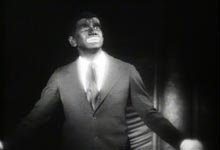
Even so, The Jazz Singer, which is mostly silent, is a bit of a tough slog whenever Al isn’t singing or talking. When he is, however, the film comes to life—or more to the point, Jolson endows it with life. Watching Jolson “get hot” with “Toot Toot Tootsie” and “Blue Skies” and “My Mammy” is hard to beat, and these three sequences make it clear how the film helped push the talkies into the public consciousness. It wouldn’t be long before fictional studio mogul Herman Glogauer would complain in the Moss Hart-George S. Kaufman play Once in a Lifetime, “What did they have to go and make pictures talk for? You couldn’t stop making money. Even if you turned out a good picture, you made money. This fellow Lou Jackson sings these ‘Mammies’ at them and everybody goes crazy.” There was no question who this Lou Jackson fellow was.
Much better is The Singing Fool—a film that might be better described as a part-silent rather than a part-talkie, since the silent scenes here take a back seat to the talking ones. The story isn’t much—they rarely are—but the filmmaking is better and Jolson shines. He even manages to make the lachrymose laden “Sonny Boy” fairly palatable—part of the time. Unfortunately, the film so works the tune to death that by 1930 and Big Boy Jolson only has to threaten an audience with it for them to start to walk out on him. (Ego aside, Jolson had a sense of humor about himself.) Singing it once was OK, but the goo to which the film descends with Jolie and his ill-fated Sonny Boy (Davey Lee) is too much. Ironically, the song itself was sent to Jolson as a gag by tunesmiths DeSylva, Brown and Henderson, who thought it was terrible (and a little pedophilic). Jolson loved it and turned it into a hit. I’m not sure who the joke is really on.
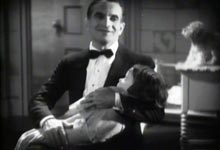
I’m skipping Say It with Songs, wherein Al goes to the big house, while his wife (Marion Nixon) becomes involved with a doctor (Holmes Herbert). Melodrama involving Jolie’s son, Little Pal (Davey Lee again), ensues—affording us a “Sonny Boy” knock-off—yes, it’s called “Little Pal.” How did you guess? I saw the film once years ago and vowed never to repeat the experience. Unfortunately, a friend of mine asked me to make a copy for that rabid Jolson enthusiast, Forrest J Ackerman (who, I should note died recently at the age of 92), so I saw it again within the past four years. Time had not helped it any, though the joke about ham at the end of the film bore a much better gag ending on Big Boy.
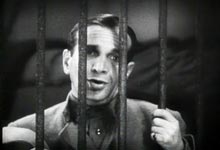
The jury’s out on whether or not I want to deal with Mammy (1930). It’s actually one of Jolson’s better made film (direction by Michael Curtiz helps) and it’s the only film to deal with Jolson’s minstrel persona. I’ll add that it contains the anthemic Jolson song, “Let Me Sing and I’m Happy,” the pleasant “Across the Breakfast Table Looking at You,” and is the only of his films to showcase his novelty songs. Here we get “Who Paid the Rent for Mrs. Rip Van Winkle?” and “Why Do They All Take the Night Boat to Albany?”—comic turns that suggest that Mrs. Van Winkle was ver accomodating with the landlord, and that the night boat in question was a prime make-out spot. It’s often forgotten that Jolson was originally considered a comedian more than anything else (I have an ancient 78 where he’s billed on the label as “comedian with orchestra”), and it’s nice to see that spotlighted here.
Even so, Mammy is otherwise pretty dull melodrama and the print that was extant when the laserdisc was made isn’t very good. I understand that a much better print was subsequently found—complete with the Technicolor scenes intact—and that it was screened in 2002. I think I might hold out in the hopes that Warner Bros. might release this version on DVD.
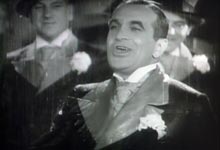
I will take Big Boy, however, even if it means throwing politically correct caution to the winds. I’m sorry, but the movie—though crudely made—is a lot of fun. Jolson plays Jolson playing Gus, the old family retainer for the Bedfords of Kentucky. There’s a sort of a plot—and a bizarre flashback where Gus gets the better of a nasty “knightrider” (Ku Klux Klansman) played by Noah Beery, Sr.—about Gus being unfairly disgraced by unscruplous gamblers to keep him from riding the horse, Big Boy, in the Kentucky Derby. It hardly matters since the whole thing exists merely for Jolie to sing and make smart remarks to his supposed white “betters.” (In this regard, the film is almost subversive.)
In essence, the concept of Big Boy is to replace Jolson’s attachment to some ailing or dying offsprint with one to a horse. It’s frankly less cloying and the horse playing Big Boy is a much more appealing actor than Davey Lee. The whole film, however, would be worth it if only for the final scene where Jolson steps out of his blackface character to become himself, tell us how the race ended, threaten us with “Sonny Boy,” and then sing one those “Mammies” at us. The trick is that here he turns the whole mammy business into a joke as he waxes with great emotional fervor about trudging to his old cabin and seeing his mammy and his dog waiting for him—only to get worked up about a “great big luscious ham” hanging in the window,” before suddenly realizing, “That ain’t my house.”
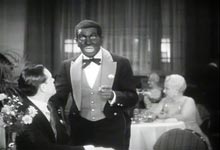
After Big Boy, Jolson was off the screen for three years. He returned with Lewis Milestone’s Hallelujah, I’m a Bum!, which I might skip. No, it’s not because it’s a lesser movie. It’s not. In fact, it’s probably the best movie he ever made. It’s certainly the most cinematic, even if it’s cinematic quality is downright strange. I’ve written about the film before and its director’s apparent belief that the world was just lying in wait for a musical in the style—and following the montage dictates—of Sergei Eisenstein. (We should probably be grateful that Milestone never thought of Potemkin: The Musical.) Strange as it is, it’s also unforgettable and would make any list of mine of essential musicals. But the thing is I watch it fairly frequently anyway.
Wonder Bar, on the other hand, is a given. This is a weird assemblage of thwarted love, young love, infidelity, gigolos, accidental homicide and suicide (all good comic stuff, you’ll agree) punctuated by songs and Busby Berkeley production numbers. It’s that last—or more correctly the last number in the film—that has caused Wonder Bar to be the most problematic in Jolson’s oeuvre. The song is “Goin’ to Heaven on a Mule,” and that ought to give you a clue as to where this thing is going. That clue, however, doesn’t even scratch the surface of its actual jaw-dropping quality.
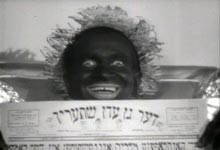
The number presents blackface Jolson (“in one of his characteristic numbers,” says Dick Powell by way of introduction) seemingly crossing Wagner’s rainbow bridge into a stylized art deco heaven (the concept is theologically ambitious, you see). Now, there’s already been some dubiousness with a song that opens with the line, “Ever since I was a little pickaninny, I rode an old Missouri Mule,” and proceeds to catalogue every stereotype you can imagine, but it all pales into insignificance when we get to heaven and see such sights as “Possum Pie Grove” and “Pork Chop Orchard” (“where de pork chops am a-growin’ on the trees), not to mention Jolie shooting craps with Emperor Jones and a tap dancer (Hal Le Roy in blackface—and legs) emerging from an oversized watermelon. (I am not making this up.) Oh, I left out the sight of Al reading a Hebrew newspaper. It doesn’t help that it’s one of Berkeley’s cheesiest looking numbers and that the basic heaven concept is a ripped off blend of the afterlife in Frank Borzage’s Lilliom (1930) and that envisioned in 1934 by Fritz Lang for his version of Lilliom. Still, it needs to be seen—if only because you’ll never believe it otherwise.

Essential for other reasons is Go Into Your Dance (1935)—notable for being the only screen teaming of Jolson and his then-wife Ruby Keeler. It’s also a pretty good film that has the usual melodrama (this time Al crosses some gangsters) and an above average set of songs, including “About a Quarter to Nine,” “Go Into Your Dance” and “She’s a Latin from Manhattan.” The size of the production is scaled down. There’s no Berkeley here, but the less lavish stagings attest to the fact that there really wasn’t much percentage in burying Jolson in a huge production number as Wonder Bar had done. But the move clearly indicated a cost-conscious attitude that would be even more evident on Jolie’s last starring film, The Singing Kid (1936).
In a lot of ways, The Singing Kid is lesser Jolson. He too often takes a backseat to other performers, including the obnoxious Yacht Club Boys (kind of like a more annoying version of the Ritz Brothers, if such a thing can be imagined) and Wini Shaw in blackface. Also, Jolie gets below the title billing (ouch!) and a B list leading lady (Beverly Roberts)—and is saddled with another child actor, though Sybil Jason is a lot more charming than Davey Lee ever was. Yet there’s much to prize here. There’s almost no pretense that Al Jackson is anybody, but Jolson. The film even starts with a montage of Jackson’s greatest hits—all of which happen to be Jolson’s hits in a medley performed in front of backdrops depicting the exteriors of theaters advertising Jolson shows or movies. It gives the film a nice sense of rounding out Jolson’s career.
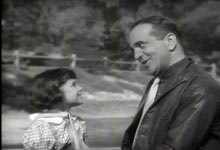
Then too, the songs are good. The opening number, “I Love to Sing-A,” is stunning as performed by Jolson in a duet with Cab Calloway who sing to each other from opposing penthouses (Cab’s whole band is on his terrace, which the neighbors must have loved). The big number, “Save Me Sister,” with Calloway and Wini Shaw is very good, too. Similarly, the song he sings to Sybil Jason, “You’re the Cure for What Ails Me” is surprisingly pleasant, instead of being one of those gooey early talkie things. All in all, it’s a pleasant movie that adds a nice coda to Jolson’s real film career. Oh, he’d be back in small roles, and The Jolson Story would put him back on top as an entertainer (if not a movie star), but it would never be quite the same thing.
And The Singing Kid will finish off my Christmas. I leave you to your own devices for your seasonal viewing—and with those immortal words from Mr. Dickens’ Tiny Tim, “Clapton, bless us—everyone.” At least, I’m sure that that’s how Dickens would have put it if he’d had the advantage of a rock music background.




I’m thinking it’s time for a renewed look at Santa Clause Conquers the Martians with Pia Zadora.
I don’t dip too far back in time for Christmas viewing, probably A Christams Story being as far back as I care to go (I have the lines to It’s a Wonderful Life memorized by now).
I watched a film over the weekend that is ‘Christmas-ie” that was quite enjoyable for a different holiday take. It was called Love Actually, with Hugh Grant, Laura Linney, Colin Firth and many others. It was a definite ‘feel good’ movie for the holidays.
I don’t dip too far back in time for Christmas viewing, probably A Christams Story being as far back as I care to go
That seems odd to me, but then I spend maybe half to two-thirds of my off-duty time with films from 1927-1935. I broke down and got a new 50 inch TV last week — and one of the first things I went for was the 65mm widescreen version of Roland West’s The Bat Whispers (1930).
If I was going to be a Xmas traditionalist, I’d go for Miracle on 34th Street (1947), The Lemon Drop Kid (1951), or A Christmas Carol (1951). I keep living in hope that Fox Movie Channel will dust off Life Begins at 8:30 (1942) if only for the sight of Monty Woolley as an inebriated department store Santa telling the crowd, “I hate you. I hate you all.” (Do not hold me to the accuracy of that quote. Last time I saw this I was 16 years old.)
I have the lines to It’s a Wonderful Life memorized by now
I positively dislike this movie and have from the moment I set eyes on it, which came a shock because I was really hot for Frank Capra at the time (it was around the time he put out his autobiography, which was a huge deal for cinephiles at the time).
On the other hand, I love Love Actually. It even rated pretty high on my 10 Best list the year it came out, if I recall.
I love It’s a Wonderful Life and cry just looking at the DVD box.
I also LOVE LOVE LOVE Jolson. I’ve seen The Jazz Singer and a long time ago I watched Wonder Bar. It was like a car crash set to film- in a good way. It’s hard to get past the Riding the Mule into Heaven scene.
Thanks for the article, Ken. Now I’m going to listen to Jolie sing “Alabammy Bound” and drink a fine glass of bourbon.
“A Christmas Carol (1951).”
A good choice. I also like the later version with George C. Scott.
I love It’s a Wonderful Life and cry just looking at the DVD box.
I cry when I see the box, too, but it’s out of fear that someone might try to make me watch it.
I also LOVE LOVE LOVE Jolson. I’ve seen The Jazz Singer and a long time ago I watched Wonder Bar. It was like a car crash set to film- in a good way. It’s hard to get past the Riding the Mule into Heaven scene.
I knew there was at least one other Jolson fan out there — and that his name was Jason Bugg. One of these days we’re gonna have to set him up with some of these other movies.
A good choice. I also like the later version with George C. Scott.
Much as I like George C. Scott, he’s just not Alastair Sim.
What I would really like to see again is the TV production of Pickwick with Harry Secombe, which was sold in syndication around 1970-71. After that, it vanished so completely that — last I knew anyway — it isn’t even listed in Secombe’s credits on the IMDb. (Then again, Bryan Fotbes’ Elton John documentary, Say Goodbye, Norma Jean, that ran in a 90 min. version on ABC in 1974 and later in an edited 60 min. version, has also completely disappeared, but that’s another story.)
…and a thick slice of something that wouldn’t be served in his own household.
Wonderful turn of phrase, that.
I’ve never seen Alastair Sims in A Christmas Carol (horrors!), so Scott remains my favorite Scrooge. But like one’s first love, I’ll never forget my first introduction to the character, courtesy of Mr. Magoo.
Rocker Todd Rundgren had an album in the 70s called A Wizard, A True Star, which included a song entitled “Just Another Onionhead/Da Da Dali.” “Onionhead” interrupted is “Dali” , a catchy little tune that is sung with a 20s sort of vocal quality, referencing a number of images from Dali’s career, and then segues back into “Onionhead.”
A few years later, one of my film clases showed The Jazz Singer, and I heard “Toot-Toot-Tootsie” for the first time, which gave me a great, big “Wait a minute…” moment, as you might guess from the “Dali” lyrics below:
“Dada Dali goodbye, dada Dali don’t sigh
Your soft alarm clocks quake me
So boil your beans and meet me at Perignon Station
Crutch me Dali again, lobster telephone friend
Stay in your seat, watch what you eat
If you don’t get a dead mule then you’ll know I’m in heat
Dada Dali hello, dada Dali you’re…(just another onionhead.”)(Available on Rhapsody.)
And now that this has gone on far too long, I’ll just say that my ideal Christmas double-feature would be A Christmas Story and Black Christmas, as both are classics that were directed by the late Bob Clark – a sweet AND sour Christmas viewing experience, you might say.
If you don’t get a dead mule then you’ll know I’m in heat
This may well be one of the greatest lyrics I’ve ever encountered — in or out of Andalusia! It even transcends the magic of Ringo’s “I’m sorry that I doubted you, I was so unfair. You were in a car crash and you lost your hair.”
I’ll just say that my ideal Christmas double-feature would be A Christmas Story and Black Christmas, as both are classics that were directed by the late Bob Clark – a sweet AND sour Christmas viewing experience, you might say.
I must say I never thought of the two in quite this way, but it’s perfectly accurate.
Now, about never having seen the Sim Christmas Carol…
I wrote anothr of my interminable posts here, but I lost it to what I guess is a timeout. So…
Now, about never having seen the Sim Christmas Carol…
I’m working my way through the nine or so parts on YouTube. With two parts seen, I’m enjoying it, although Sim is a little theatrical for my taste. But as a Ken Russell fan, who am I to complain.
As a historical note, The Internet Archive carries the first sound version of ACC, Scrooge, starring Seymour Hicks.
http://www.archive.org/details/Scrooge_1935
The Hicks version — if memory serves — is fairly dire. Now, for the real deal, what you need is the “A Christmas Carol by Kind Permission” episode of The Goon Show radio program. I will say, however, that these shows only work if you listen to a dozen or so to get the tone and establish the characters and running gags in your mind.
Dear Mr. Hanke: Thanks for the nice words in regards to my role in THE SINGING KID. May I just make one comment. In regards to Beverly Roberts she was not possibly termed a B actress because The Singing Kid was her very first movie. BTW she just turned 92 and can easily bend down and touch her toes!!!! I am in awe of her.
Blessings to you and yours. BTW You probably remember me from my WB movies as WB’s first kid star under long term contract but I bet you didn’t know that three years after working with Jolie I portrayed the character of BECKY in THE LITTLE PRINCESS at Fox.
I can’t tell you how delighted I am to hear from you! Well, obviously I can because I just did, but it is certainly is a treat and an unexpected one. Sorry I referred to Beverly Roberts as a B list actress (not a B actress in the sense of, say, Louise Currie who only ever worked in actual B pictures). Honestly, the only other thing I can recall of hers is the programmer Two Against the World (a remake of Five Star Final), which came out the same year. She’s very good in both. I don’t remember China Clipper — also from 1936 — though I know I’ve seen it. She should have had a bigger career considering that in that one year she co-starred with Jolie, Bogie and Pat O’Brien.
It’s years since I saw The Little Princess, so I’ll have to confess I don’t remember it very clearly. The fact that it fell into public domain resulted in so many awful copies flooding the market that it’s one Shirley Temple picture I’ve tended to avoid.
Of course, I’ve got to ask — assuming you ever stop back by here — what it was like working with Jolson.